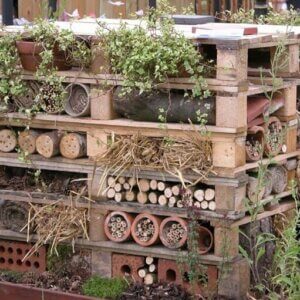Composting is a really green thing to do, right? I’ve always thought so since my Grandfather taught me to do it in the early sixties. Large-scale composting is getting to be quite the rage.
The City of San Francisco attracted a great deal of attention with it’s mandatory food scrap recycling program and lots of local wineries are bragging about their use of that compost to fertilize their vineyards.

I just read today about how the Langley Parish Council in England is setting up a village compost and “set an example to small villages as the UK strives to battle climate change.”
Unfortunately, I recently learned that they and San Francisco and the Napa wineries might actually be doing is contributing to climate change.
Climate change science often ends up challenging things we think we know.
Inconvenience
The idea of composting is to provide plenty of moisture and oxygen so that microbes will digest the easily available organic matter and generate a great deal of metabolic heat in the process. What is left at the end is a sterilized source of more resistant organic matter that can enrich a soil.
Related Post: The Story of Our Waste
Composting of wastes is done with very good intentions, but there is the inconvenient truth that even a very well run large-scale compost operation emits some methane.
But if you stop to think about it, as much as you intend to have oxygen available to the whole pile (aerobic conditions), there are definitely going to be micro-sites that are going to lack oxygen (anaerobic conditions) particularly when there is huge oxygen demand during the peak of the process. That is where methane gets made.
The Science
There are actually very few published scientific studies about greenhouse gas emissions from composts, but the two that I have been able to find show that around 2-3% of the original carbon in the manure or green waste is emitted as methane (21X carbon dioxide in GHG potential) and there is also a little nitrous oxide as well (310X carbon dioxide in GHG potential). That doesn’t sound at all bad until you do some math with the values in these publications.
The Math
If you think of it in terms of delivering a hundred pounds of nitrogen/acre (as you would for something like an organic vegetable crop) you would need to start with 8600 pounds (on a dry weight basis) of cow manure (because there is a loss of mass and because the compost is only 1.7% nitrogen). The greenhouse gas emissions are the equivalent of 0.74 lbs CO2 per dry lb of manure. That means that the “carbon footprint” of the 100 lbs of N in compost fertilizer is 6,403 lbs CO2. That is 14.6 times as much as for synthetic urea fertilizer! It is the equivalent of burning 331 gallons of gasoline! (if you are interested you can see a more detailed explanation).
Now What?
When I first did these calculations I was shocked. I did them over and over to make sure I wasn’t in error. I’ve run this by a number of appropriate USDA scientists. They too were surprised, but confirmed my math. All of a sudden, compost isn’t looking like such a “green” fertilizer. I’ve tried to find out whether anyone has measured the emissions from San Francisco’s operation but haven’t had any luck.
I’ll discuss this in a later post, but there are some better options for these waste streams as carbon-neutral energy sources. I wouldn’t worry about your back yard compost, this is probably just an issue at a commercial scale.










































Environmental benefits or harms cannot be reduced to a single metric – even if climate change is the biggest threat we face.
Composting converts what might otherwise be tossed into a landfill (or burned) into useful soil organic matter. Carbon will be released no matter what is done – the proper question is which choice produces the most appropriate benefit along with those costs.
The greenhouse gases are part of the natural cycle though, as opposed to being locked up in a toxic landfill. Maybe if we were wiser we would not only compost at the city level, but we would harness the heat and gases that it puts off for better use as well as generating electricity and fertilizer.
-Tyler
Tyler,
Exactly. Manures and food scraps have more value to society as a fuel than as a problematic fertilizer. This could be done with an anaerobic digester or in a fast pyrolysis system
There’s no need for the two to be mutually exclusive – anaerobic digestion can produce compost-like materials as well as methane.
Landfills also produce massive amounts of methane. Why not harvest it like some landfills are doing.
Just as what Ken said, if we were to toss these same items into the trash, then it would produce the same amount of greenhouse gases, but nobody is getting use out of them. With the state of our landfills being overcrowded, anyway we can prevent things from ending up in the landfill help, whether it’s for composting or fuel as Steve suggests.
My point isn’t that a city like SF shouldn’t to something with food scraps. Its that they should consider other options like methane digesters or pyrolysis. Some landfills also harvest the methane they generate which is a not as bad option
Regarding the nitrogen source, no produce farmers I ever knew use cow manure to boost nitrogen. They use it to build their soil. For nitrogen, chicken manure compost is popular.
Regarding the implied technique, power-intensive hot composting, it’s important to note that it’s not the only way to compost. Layered windrows that are never turned produce the best compost in my experience. Layered windrows may emit less greenhouse gases.
Even if there is a short-term greenhouse gas to creating compost, it may pay off well in the end in terms of that same metric. Getting more carbon into the soil, the basic premise of composting, can help poor soils such as desert soils develop positive feedback loops where they progressively capture more carbon instead of remaining barren.
Finally, I think the basic point to keep in mind is that we need to get as much carbon back into our soil as possible. Composting is currently the best-known way to do that. Perhaps this article can spur some improvements in composting techniques.
Steve:
GREAT post! May I have your permission to “quote” it in my Examiner.com article (I’m the Seattle Green Living Examiner)? I’m putting together an article on green living called “Now What? What to do when your efforts to be green… aren’t”. This is a great example.
Another one is the State of Washington’s law that collecting rainwater is (technically) illegal. (Colorado and Utah have similar laws).
Good work!
Dave Kuhns, web content writer, marketing consultant,
http://www.cyranowriter.com
http://www.examiner.com/x-17874-Seattle-Green-Living-Examiner
Would it possible for you to do some more research and get back to us with a follow=up article, preferably with a less dramatic title and a little more science than a back-of-the-napkin calculation? Perhaps you could google “Stop Trashing the Planet” and read that first. Then look for Dr. Sally Brown’s PowerPoint “A Green House Gas Balance for Compost.” These two pieces alone might get you thinking about the carbon sequestration properties of composting and carbon-amended soil, the avoidance of landfill-generated methane (72 times more potent as a greenhouse gas, not 21 times), and life cycle analysis considerations that might help you look at composting in a more rational perspective. My apologies, I do not mean to be snide, but your argument is quite unfair, specious, and misleading to readers who would be much better served to be presented the full picture of composting and organic resource management in cyclical, not linear form.
Several metrics and situations have been ignored by this analysis, some of which are obvious and others that may not be. The obvious one is compost feedstocks are biogenic sources of CO2 unlike Urea. Less obvious, are that studies at UC San Diego done on emissions of Volatile Organic Compounds (VOC’s) compared leaving yard debris including grass on a lawn vs. large scale composting saw a significant reductions in VOC generation in largescale composting. Also research has shown methane is degraded before being emitted from compost pile surfaces, and nitrous oxide conversions generally happen at ambient soil temperatures, not active hot piles. I am all for Anaerobic then Aerobic controlled processing of organics, but there is no need to bash one for the other.
As some of the other commenters have said, anaerobic digestion solves this problem while also creating renewable energy out of the captured methane. What’s left in the AD after biogas production is complete is very high quality fertilizer, better quality than compost in fact because it has a higher concentration of nitrogen. However, only about half of the original volume in weight remains.
The gas can be burned in a turbine to produce electricity and heat, and it is not intermittent power like solar and wind.
The advantages of AD over composting are clear. These projects are economically and environmentally feasible, they just need more attention as a waste disposal and energy option for communities.
Well, the alternative to composting organic materials–landfilling–creates even MORE methane emissions because it ALL breaks down anaerobically. Plus, the breaking down of organics occurs automatically in nature… does that mean we should blame Mother?
Check out http://www.stoptrashingtheclimate.org and http://www.cool2012.com for the science behind Zero Waste initiatives like composting.
no one seems to get the point of source reduction! if we consumed less, there would be less waste to have to compost, landfill, burn, etc…..reduce, reuse, recycle….in that order.
Thunderbird 3: I love Firefox but it loads pages slowly. ,
So this is true that compost releases some methane but your calculations are only semi accurate and the reason that they are only semi accurate is because the amount of methane released depends on the management used. Or in other words how often it is turned because if it is over turned it actually releases more methane but additionally if it is under turned it makes more methane so when it is turned more is released. If managed properly less methane is released and if you look at recent scientific journals you can find studies to support this. Therefore, your calculations do not take into account the management so they cannot possibly be entirely accurate.
Additionally though, your paper is very one sided I mean coming up with problems to compost is interesting but what is your solution? Because compost is still reducing methane and other greenhouse emissions by drastic amounts. Landfills are the number one producers of methane in the U.S.
Jamie,
You are right that the details of the management of the compost are critical – the papers I sighted were from pretty typical compost operations. The manure one was 5 turns over 99 days. How would you rate that for quality? I’d be interested in knowing about the papers you mentioned.
I also agree that composting of organic wastes is infinitely better than putting them in a land fill. It is just that there are two, even better options if you have done all the work of collecting. Anaerobic digesters or fast pyrolysis systems can harness the residual energy in that waste which is far more valuable to society and to the environment than the small amount of residual nitrogen.
My real argument with composting and even manure is that we are wasting good clean energy to make a problematic, pollution and greenhouse gas generating fertilizer. All nitrogen fertilizers have those potentials, but these bulky, high phosphorus, uncontrolled release fertilizers don’t have the flexibility of a synthetic fertilizer for minimizing those impacts. There are actually more natural ways to build organic matter in the soil than importing it at several tons/acre/year (continuous no-till farming with the use of cover crops)
My ideal would be to take the energy from the waste and use it to run a small-scale Haber-Bosch process to make “carbon-neutral, synthetic nitrogen”
Again, thanks for the good input.
1) You would never apply an organic fert based on the same nutrient needs as a Chemical fert program
2) You would never apply a mature compost to fulfill a Nitrogen need. (You would apply the raw manure that has a much higher soluble N%)
3) Sending the waste to a landfill or a waste pile would be MUCH more an-aerobic, and release MUCH more CH4 into the atmosphere than even a large scale compost pile.
4) Before you dump numbers, ensure that you are not comparing apples to oranges (which in this case you are)
Just read your responses. Just FYI, compost isn’t to be used as a fertilizer. There are much more important things from compost than nutrient needs. Thus is is a soil amendment. Again, apples to oranges.
What if, instead of allowing the methane to escape to the atmosphere, it was collected and used as is done in some landfills? I DO realize this then releases CO2, another greenhouse gas, but then at least non-fossil fuel energy is consumed which is a good thing, and CO2 is a much less potent greenhouse gas than methane, also a good thing.
Great article our neighborhood is currently fighting installation of a lg. commercial sludge composting facility and i would like to know how much nox gets produced during the anaerobic stages Can you help? thanks a bunch mike
Such problems would not occur if composting was made on-site with capable and advanced equipment such as those manufactured by http://www.kollvik.com
What about converting the abandoned quarries into composting sites?Is it possible to fill huge urban green waste in air tight pits in the abandoned quarries?how much of methane gas will be formed inside?What about manure?can we tap this methane for cooking?
Shareef,
Some land fills are designed to capture the methane that comes out of them. I suppose an abandoned quarry could serve that function if it wasn’t flooded. The best alternative for city food wastes and for manure is an anaerobic digester. It turns the carbon in the waste into methane for energy. The issue is that it is capital intensive and requires maintenance. As someone commented earlier, the fiber that comes out of the digester isn’t a good fertilizer, but it is a good soil amendment to build soil carbon in things like vegetable crops that can’t really be grown “no-till.”
Finally! When looking at options everything must be considered. Of course landfill is not an option but just because our grandfathers did it and because nature does it, it does not mean that it is the best. Anyone wanna sniff some volcane fumes? It’s from nature too.
I understand what you are saying. However, you are incorrect. If the waste is not composted it would entirely decompose anaerobically which is worse than if it was composted where it is only partially anaerobic and mainly aerobic.
However, if we didn’t create the waste in the first place, the waste would not decompose at all!
Sort of a mute point wouldn’t you say? There is always going to be waste the best option is to deal with it in the most effective way possible.
mute point? did you mean “moot point”?
Or dispose of it responsibly (see my post)
I disagree on two key points: first, the baseline scenario for most manure is that it is being stored anaerobically in a manure pool until it either evaporates or gets brought out to the fields – in either case enormous methane emissions result that exceed those resulting from composting.
second, compost is made up of carbon which is stable for varying degrees of time, up to more than 100 years. That sequesters large amounts of CO2.
Add those two together and you end up with enormous GHG reductions from composting plus you end up with more fertile soils.
It’s good to note that a GWP of x21 for Methane over 100 years is on the lower end of estimates. Also, the GWP of methane changes over time (its life cycle is shorter than CO2). So the GWP of methane over 20 years is actually x56.
The layers in modern landfills are packed so tight that very little gas is able to escape. A good friend worked on a project at 3 local landfills for a methane harvesting system. When the $30 million dollar project at the last landfill was complete we asked how the systems seemed to perform. We were astonished to find out barely enough methane to run a few little facility buildings on the landfill site. During the engineering process they did not factor in the cell layers being packed so tightly would greatly slow the gas emitting process. What I have learned about commercial compost is it to will produce methane, co2 and nitrous oxide as well. If people really want to help the planet they need to stop driving 300 plus horsepower gas thirsty suv’s . Everyone and their dog seems to drive one plus the Dodge ram on the driveway as well.
Decomposition occurs all the time, fall leaves, fallen branches, and trees.
It is the reason there is top soil.
If your city is collecting yard waste, or you are,
You will, of course, ignore this alarmist.
Where as if this or ANY organic waste is fed to BSF larvae it becomes 40% protein, 30% oil, and 5% dissolved calcium as mature larvae and is a near perfect protein/oil ratio for chicken, fish, and hog food.
This FB page explains how this could be integrated with addiction treatment or help at risk youth learn a lifetime marketable skill.
https://www.facebook.com/Growing-Hope-for-Humanity-347828952057138/